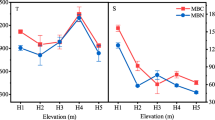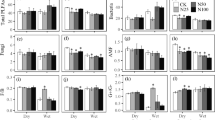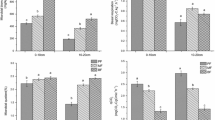Abstract
Forest management with N-fixing trees can improve soil fertility and tree productivity, but have little information regarding belowground carbon processes and microbial properties. We aimed to evaluate the effects of three forest management regimes, which were Erythrophleum fordii (N-fixing tree), Pinus massoniana (non-N-fixing tree), and their mixed forest, on soil respiration and microbial community composition in subtropical China, using Barometric Process Separation and phospholipid fatty acid profiles, respectively. We found that the inclusions of N-fixing species in forests significantly increased the soil respiration, but have no effects on SOC and ecosystem total C stock. In addition, soil microbial communities were obviously different among the three forest management regimes. For instance, total and bacterial PLFAs were higher in the E. fordii and mixed forest than in the P. massoniana forest. Conversely, fungal PLFAs in the P. massoniana forest were elevated versus the other two forests. Soil total N, nitrate-N and pH were the key determinants shaping the microbial community composition. Our study suggests that variations in soil respiration in the studied forests could be primarily explained by the differences of root biomass and soil microbial biomass, but not soil organic carbon. Although soil fertility and microbial biomass were promoted, N-fixing plantings also brought on increased CO2 emissions in laboratory assays. The future decision of tree species selection for forest management in subtropical China therefore needs to consider the potential influences of tree species on CO2 emissions.




Similar content being viewed by others
References
Austin AT, Yahdjian L, Stark JM, Belnap J, Porporato A, Norton U, Ravetta DA, Schaeffer SM (2004) Water pulses and biogeochemical cycles in arid and semiarid ecosystems. Oecologia 141:221–235
Bååth E, Anderson TH (2003) Comparison of soil fungal/bacterial ratios in a pH gradient using physiological and PLFA-based techniques. Soil Biol Biochem 35:955–963
Balser TC, Wixon DL (2009) Investigating biological control over soil carbon temperature sensitivity. Glob Chang Biol 15:2935–2949
Bini D, Santos CA, Bouillet JP, Gonçalves JLM, Cardoso EJBN (2013) Eucalyptus grandis and Acacia mangium in monoculture and intercropped plantations: evolution of soil and litter microbial and chemical attributes during early stages of plant development. Appl Soil Ecol 63:57–66
Binkley D, Senock R, Bird S, Cole TG (2003) Twenty years of stand development in pure and mixed stands of Eucalyptus saligna and nitrogen-fixing Facaltaria moluccana. For Ecol Manag 182:93–102
Bossio DA, Scow KM, Gunapala N, Graham KJ (1998) Determinants of soil microbial communities: effects of agricultural management, season, and soil type on phospholipid fatty acid profiles. Microb Ecol 36:1–12
Boyle SA, Yarwood RR, Bottomley PJ, Myrold DD (2008) Bacterial and fungal contributions to soil nitrogen cycling under Douglas fir and red alder at two sites in Oregon. Soil Biol Biochem 40:443–451
Brüggemann N, Rosenkranz P, Papen H, Pilegaard K, Butterbach-Bahl K (2005) Pure stands of temperate forest tree species modify soil respiration and N turnover. Biogeosciences Discuss 2:303–331
Cao Y, Fu S, Zou X, Cao H, Shao Y, Zhou L (2010) Soil microbial community composition under Eucalyptus plantations of different age in subtropical China. Eur J Soil Biol 46:128–135
Carnevale NJ, Montagnini F (2002) Facilitating regeneration of secondary forests with the use of mixed and pure plantations of indigenous tree species. For Ecol Manag 163:217–227
Carreiro MM, Sinsabaugh RL, Repert DA, Parkhurst DF (2000) Microbial enzyme shifts explain litter decay responses to simulated nitrogen deposition. Ecology 81:2359–2365
Chai Q, Huang P, Huang GB (2004) Effect of intercropping on soil microbial and enzyme activity in the rhizosphere. Acta Prataculturae Sin 14:105–110
Chen ST, Huang Y (2006) Determination of respiration, gross nitrification and denitrification in soil profile using BaPS system. J Environ Sci 18:937–943
De Vries FT, Hoffland E, van Eekeren N, Brussaard L, Bloem J (2006) Fungal/bacterial ratios in grasslands with contrasting nitrogen management. Soil Biol Biochem 38:2092–2103
Dix NJ, Webster JR (1995) Fungal ecology. Chapman & Hall, London
Dong W, Zhang X, Dai X, Fu X, Yang F, Liu X, Sun X, Wen X, Schaeffer S (2014) Changes in soil microbial community composition in response to fertilization of paddy soils in subtropical China. Appl Soil Ecol 84:140–147
Epron D, Bosc A, Bonal D, Freycon V (2006) Spatial variation of soil respiration across a topographic gradient in a tropical rain forest in French Guiana. J Trop Ecol 22:565–574
Forrester DI, Bauhus J, Khanna PK (2004) Growth dynamics in a mixed-species plantation of Eucalyptus globulus and Acacia mearnsii. For Ecol Manag 193:81–95
Forrester DI, Bauhus J, Cowie AL (2006a) Carbon allocation in a mixed-species plantation of Eucalyptus globulus and Acacia mearnsii. For Ecol Manag 233:275–284
Forrester DI, Bauhus J, Cowie AL, Vanclay JK (2006b) Mixed-species plantations of Eucalyptus with nitrogen-fixing trees: a review. For Ecol Manag 233:211–230
Franzluebbers AJ (1999) Microbial activity in response to water-filled pore space of variably eroded southern Piedmont soils. Appl Soil Ecol 11:91–101
Frostegård Å, Bååth E (1996) The use of phospholipid fatty acid analysis to estimate bacterial and fungal biomass in soil. Biol Fertil Soils 22:59–65
Frostegård Å, Bååth E, Tunlio A (1993) Shifts in the structure of soil microbial communities in limed forests as revealed by phospholipid fatty acid analysis. Soil Biol Biochem 25:723–730
Frostegård Å, Tunlid A, Bååth E (1996) Changes in microbial community structure during long-term incubation in two soils experimentally contaminated with metals. Soil Biol Biochem 28:55–63
Grayston SJ, Campbell CD, Bardgett RD, Mawdsley JL, Clegg CD, Ritz K, Griffiths BS, Rodwell JS, Edwards SJ, Davies WJ (2004) Assessing shifts in microbial community structure across a range of grasslands of differing management intensity using CLPP, PLFA and community DNA techniques. Appl Soil Ecol 25:63–84
Griffiths BS, Ritz K, Ebblewhite N, Dobson G (1998) Soil microbial community structure: effects of substrate loading rates. Soil Biol Biochem 31:145–153
Hackl E, Pfeffer M, Donat C, Bachmann G, Zechmeister-Boltenstern S (2005) Composition of the microbial communities in the mineral soil under different types of natural forest. Soil Biol Biochem 37:661–671
Hertel D, Harteveld MA, Leuschner C (2009) Conversion of a tropical forest into agroforest alters the fine root-related carbon flux to the soil. Soil Biol Biochem 41:481–490
Högberg MN, Högberg P, Myrold DD (2007) Is microbial community composition in boreal forest soils determined by pH, C-to-N ratio, the trees, or all three? Oecologia 150:590–601
Hoogmoed M, Cunningham SC, Baker P, Beringer J, Cavagnaro TR (2014a) N-fixing trees in restoration plantings: effects on nitrogen supply and soil microbial communities. Soil Biol Biochem 77:203–212
Hoogmoed M, Cunningham SC, Baker PJ, Beringer J, Cavagnaro TR (2014b) Is there more soil carbon under nitrogen-fixing trees than under non-nitrogen-fixing trees in mixed-species restoration plantings? Agric Ecosyst Environ 188:80–84
Huang X, Liu S, Wang H, Hu Z, Li Z, You Y (2014) Changes of soil microbial biomass carbon and community composition through mixing nitrogen-fixing species with Eucalyptus urophylla in subtropical China. Soil Biol Biochem 73:42–48
Ingwersen J, Butterbach-Bahl K, Gasche R, Papen H, Richter O (1999) Barometric process separation: new method for quantifying nitrification, denitrification, and nitrous oxide sources in soils. Soil Sci Soc Am J 63:117–128
Janssens IA, Lankreijer H, Matteucci G, Kowalski AS, Buchmann N, Epron D, Pilegaard K, Kutsch W, Longdoz B, Grünwald T (2001) Productivity overshadows temperature in determining soil and ecosystem respiration across European forests. Glob Chang Biol 7:269–278
Johnson DW, Curtis PS (2001) Effects of forest management on soil C and N storage: meta analysis. For Ecol Manag 140:227–238
Keiblinger KM, Hall EK, Wanek W, Szukics U, Hämmerle I, Ellersdorfer G, Böck S, Strauss J, Sterflinger K, Richter A (2010) The effect of resource quantity and resource stoichiometry on microbial carbon-use-efficiency. FEMS Microbiol Ecol 73:430–440
Liang RL (2007) Current situation of Guangxi indigenous broadleaf species resource and their development counter-measures. Guangxi For Sci 36:5–9
Liu Q, Huang Y, Zheng X (2005) Determination of upland soil respiration and its components with BaPS system. Acta Sci Circum 25:1105–1111
Lu RK (2000) Analysis methods of soil agricultural chemistry. China Agricultural Science and Technology Press, Beijing
Lucas-Borja ME, Candel D, Jindo K, Moreno JL, Andrés M, Bastida F (2012) Soil microbial community structure and activity in monospecific and mixed forest stands, under Mediterranean humid conditions. Plant Soil 354:359–370
Lundquist EJ, Jackson LE, Scow KM, Hsu C (1999) Changes in microbial biomass and community composition, and soil carbon and nitrogen pools after incorporation of rye into three California agricultural soils. Soil Biol Biochem 31:221–236
Martin JK (1971) 14C-labelled material leached from the rhizosphere of plants supplied with 14CO2. Aust J Biol Sci 24:1131–1142
Mathesius U (2001) Flavonoids induced in cells undergoing nodule organogenesis in white clover are regulators of auxin breakdown by peroxidase. J Exp Bot 52:419–426
Mendham DS, Sankaran KV, O’connell AM, Grove TS (2002) Eucalyptus globulus harvest residue management effects on soil carbon and microbial biomass at 1 and 5 years after plantation establishment. Soil Biol Biochem 34:1903–1912
Müller C, Abbasi MK, Kammann C, Clough TJ, Sherlock RR, Stevens RJ, Jäger HJ (2004) Soil respiratory quotient determined via barometric process separation combined with nitrogen-15 labeling. Soil Sci Soc Am J 68:1610–1615
Myers RT, Zak DR, White DC, Peacock A (2001) Landscape-level patterns of microbial community composition and substrate use in upland forest ecosystems. Soil Sci Soc Am J 65:359–367
Paquette A, Messier C (2009) The role of plantations in managing the world’s forests in the Anthropocene. Front Ecol Environ 8:27–34
Priha O, Grayston SJ, Pennanen T, Smolander A (1999) Microbial activities related to C and N cycling and microbial community structure in the rhizospheres of Pinus sylvestris, Picea abies and Betula pendula seedlings in an organic and mineral soil. FEMS Microbiol Ecol 30:187–199
Raich JW, Schlesinger WH (1992) The global carbon dioxide flux in soil respiration and its relationship to vegetation and climate. Tellus B 44:81–99
Resh SC, Binkley D, Parrotta JA (2002) Greater soil carbon sequestration under nitrogen-fixing trees compared with Eucalyptus species. Ecosystems 5:217–231
Rosenkranz P, Dannenmann M, Brüggemann N, Papen H, Berger U, Zumbusch E, Butterbach-Bahl K (2010) Gross rates of ammonification and nitrification at a nitrogen-saturated spruce (Picea abies (L.) Karst.) stand in southern Germany. Eur J Soil Sci 61:745–758
Rousk J, Brookes PC, Bååth E (2009) Contrasting soil pH effects on fungal and bacterial growth suggest functional redundancy in carbon mineralization. Appl Environ Microb 75:1589–1596
Ryan MG, Law BE (2005) Interpreting, measuring, and modeling soil respiration. Biogeochemistry 73:3–27
Sakamoto K, Oba Y (1994) Effect of fungal to bacterial biomass ratio on the relationship between CO2 evolution and total soil microbial biomass. Biol Fertil Soils 17:39–44
Schlesinger WH, Andrews JA (2000) Soil respiration and the global carbon cycle. Biogeochemistry 48:7–20
Sheng H, Yang Y, Yang Z, Chen G, Xie J, Guo J, Zou S (2010) The dynamic response of soil respiration to land-use changes in subtropical China. Glob Chang Biol 16:1107–1121
Shi B, Gao W, Jin G (2015a) Effects on rhizospheric and heterotrophic respiration of conversion from primary forest to secondary forest and plantations in northeast China. Eur J Soil Biol 66:11–18
Shi S, Han P, Zhang P, Ding F, Ma C (2015b) The impact of afforestation on soil organic carbon sequestration on the Qinghai Plateau, China. PloS One 10:e0116591
Six J, Frey SD, Thiet RK, Batten KM (2006) Bacterial and fungal contributions to carbon sequestration in agroecosystems. Soil Sci Soc Am J 70:555–569
Soil Survey Staff of USDA (2006) Keys to Soil Taxonomy, United States Department of Agriculture (USDA). Natural Resources Conservation Service, Washington, DC
State Soil Survey Service of China (1998) China soil. China Agricultural Press, Beijing
Tang X, Liu S, Zhou G, Zhang D, Zhou C (2006) Soil-atmospheric exchange of CO2, CH4, and N2O in three subtropical forest ecosystems in southern China. Glob Chang Biol 12:546–560
Ushio M, Wagai R, Balser TC, Kitayama K (2008) Variations in the soil microbial community composition of a tropical montane forest ecosystem: does tree species matter? Soil Biol Biochem 40:2699–2702
Vesterdal L, Clarke N, Sigurdsson BD, Gundersen P (2013) Do tree species influence soil carbon stocks in temperate and boreal forests? For Ecol Manag 309:4–18
Wagai R, Kitayama K, Satomura T, Fujinuma R, Balser T (2011) Interactive influences of climate and parent material on soil microbial community structure in Bornean tropical forest ecosystems. Ecol Res 26:627–636
Wang F, Li Z, Xia H, Zou B, Li N, Liu J, Zhu W (2010a) Effects of nitrogen-fixing and non-nitrogen-fixing tree species on soil properties and nitrogen transformation during forest restoration in southern China. Soil Sci Plant Nutr 56:297–306
Wang H, Liu S, Mo J, Zhang T (2010b) Soil-atmosphere exchange of greenhouse gases in subtropical plantations of indigenous tree species. Plant Soil 335:213–227
Wang Q, He T, Wang S, Liu L (2013) Carbon input manipulation affects soil respiration and microbial community composition in a subtropical coniferous forest. Agric For Meteorol 178–179:152–160
Williamson WM, Wardle DA, Yeates GW (2005) Changes in soil microbial and nematode communities during ecosystem decline across a long-term chronosequence. Soil Biol Biochem 37:1289–1301
Xu X, Hirata E (2005) Decomposition patterns of leaf litter of seven common canopy species in a subtropical forest: N and P dynamics. Plant Soil 273:279–289
Yamashita N, Ohta S, Hardjono A (2008) Soil changes induced by Acacia mangium plantation establishment: comparison with secondary forest and Imperata cylindrica grassland soils in South Sumatra, Indonesia. For Ecol Manag 254:362–370
Yang Y, Chen G, Guo J, Xie J, Wang X (2007) Soil respiration and carbon balance in a subtropical native forest and two managed plantations. Plant Ecol 193:71–84
Yuan Z, Gazol A, Lin F, Ye J, Shi S, Wang X, Wang M, Hao Z (2013) Soil organic carbon in an old-growth temperate forest: spatial pattern, determinants and bias in its quantification. Geoderma 195:48–55
Zelles L (1997) Phospholipid fatty acid profiles in selected members of soil microbial communities. Chemosphere 35:275–294
Acknowledgments
We would like to thank the Guangxi Youyiguan Forest Ecosystem Research Station for assisting with research permits and providing logistical support. We appreciate Mr. Philip C. Brookes from Rothamsted Research, Dr. Haworth Matthew, and three anonymous reviewers for their valuable comments and suggestions on the manuscript. We are grateful to Wen Wang, Pizheng Hong, Jia Xu, Haolong Yu, Jian Hao, Angang Ming, Ji Zeng, and Jixin Tang for their help with field work and laboratory analysis. A special thank goes to Shuxia Fu for PLFA extraction and Prof. Lixia Zhou for analysis and identification of PLFA extracts. This study was jointly funded by the Ministry of Science and Technology (2012BAD22B0102), the National Natural Science Foundation of China (31290223) and the Strategic Priority Program of Chinese Academy of Sciences (No. XDA05060100).
Author information
Authors and Affiliations
Corresponding author
Ethics declarations
Conflict of interest
The authors declare that they have no conflict of interest.
About this article
Cite this article
Luo, D., Cheng, R., Shi, Z. et al. Impacts of nitrogen-fixing and non-nitrogen-fixing tree species on soil respiration and microbial community composition during forest management in subtropical China. Ecol Res 31, 683–693 (2016). https://doi.org/10.1007/s11284-016-1377-4
Received:
Accepted:
Published:
Issue Date:
DOI: https://doi.org/10.1007/s11284-016-1377-4




